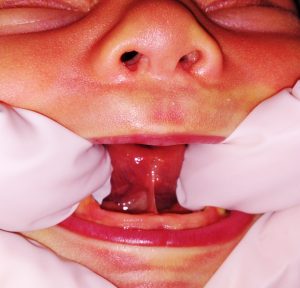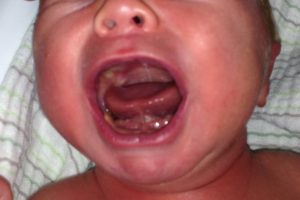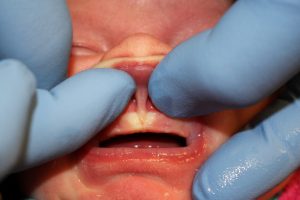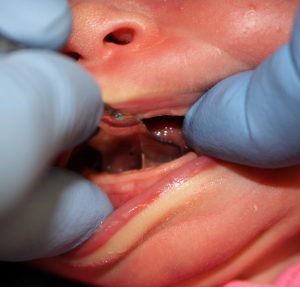By Norma Ritter, IBCLC, RLC
Have you noticed how so many babies these days are being diagnosed with tongue and/or lip ties? What are tongue ties, and do they really affect breastfeeding? Why do they seem to be more prevalent lately? How can they be treated? There is a lot of confusion about tongue ties, also known as ankyloglossia. Here is some information to help you wade through the facts and myths surrounding this topic.
What is a tongue tie?
 We are all born with some of this tissue, but for some babies it is so tight that they cannot move their tongues properly. This can affect their ability to breastfeed, or even take a bottle or a pacifier. Tongue tie can also have other serious health effects. In a similar way, a baby’s lips can be attached to his gums, making it difficult to get a good grasp on a nipple. Babies who have lip ties almost always also have tongue ties.
We are all born with some of this tissue, but for some babies it is so tight that they cannot move their tongues properly. This can affect their ability to breastfeed, or even take a bottle or a pacifier. Tongue tie can also have other serious health effects. In a similar way, a baby’s lips can be attached to his gums, making it difficult to get a good grasp on a nipple. Babies who have lip ties almost always also have tongue ties.
Tongues and lips are only considered *tied* if their movement is restricted, impairing mobility. It is important to note that many people have frenums which do not cause any problems at all. Each case needs to be assessed on an individual basis.The normal development of a fetus includes the growth of little bits of tissue called frenums (also known as frenulums), which attach the tongue to the floor of the lower jaw.
There are different kinds of tongue tie. They are classified according to where the frenum is attached on the base of the tongue.
 Class 1 ties are attached on the very tip of the tongue. These are the ones that most people think of when they talk about tongue ties.
Class 1 ties are attached on the very tip of the tongue. These are the ones that most people think of when they talk about tongue ties.
Class 2 ties are a little further behind the tip of the tongue.
Class 3 ties are closer to the base of the tongue.
Classes 1, 2, and 3 are also known as anterior ties.
Class 4 ties, also known as posterior ties (PTT), may be submucosal, ie. underneath the mucous membrane covering, so they must be felt to be diagnosed. Babies with this kind of tie are often misdiagnosed as having a short tongue. This video shows how to recognise a PTT.
Lip ties are classified in a similar way.
They range from Class 1 which are tiny, reaching only from the underside of the upper lip to the top of the gum, to Class 4, which have tissue connecting the lip to right under the gum ridge, located between the positions where the top front teeth will emerge.
 Tongue and lip ties are considered to be midline defects. Midline facial defects tend to run in families. These include cleft lip, submucosal cleft palate, cleft chin, extra or missing teeth, nasal atresia and deviated septum.
Tongue and lip ties are considered to be midline defects. Midline facial defects tend to run in families. These include cleft lip, submucosal cleft palate, cleft chin, extra or missing teeth, nasal atresia and deviated septum.
How and why does it affect breastfeeding?
Babies who are tongue-tied may have problems affecting a secure latch to the breast. They can overcompensate by increased suction causing nipple damage and pain. When they can no longer maintain latch through suction, there may be a click and a slight loss of suction or the baby may completely detach from the breast. This may not only cause pain, but also affect the baby’s ability to adequately drain the breast, leading to supply issues. In severe cases, baby is really not able to attach at all.
Why do we seem to be seeing more tongue ties now?
Babies have always been born with tongue ties. You may have heard stories of midwives who used to keep one fingernail long and sharp to cut class 1 and 2 ties at birth as a matter of routine. When bottle feeding started to become popular, it was considered to be not just a viable alternative to breastfeeding, but actually superior to it, and mothers were encouraged to feed their babies “scientifically.” Tongue tie was one of the reasons given to wean the baby to a bottle, and most of the accumulated knowledge about it was forgotten. When breastfeeding became popular again, the attention to the problem re-emerged.
 For a long time, only anterior tongue ties were recognized. It was easy to spot the typical heart-shaped tongue of ties which started at the tip of the tongue. Even so, it was very difficult to find a doctor who was willing to snip the tie, so mothers either suffered the pain or, more frequently, switched to bottle feeding.
For a long time, only anterior tongue ties were recognized. It was easy to spot the typical heart-shaped tongue of ties which started at the tip of the tongue. Even so, it was very difficult to find a doctor who was willing to snip the tie, so mothers either suffered the pain or, more frequently, switched to bottle feeding.
But lately, in the past ten years, things have started to change. There has been a tremendous amount of new information from research studies, especially about posterior ties, and the use of lasers for very delicate surgery has revolutionized the treatment. The newest research is looking into environmental factors, and the possibility of a specific gene mutation being linked to the cause of tongue ties.
In a recent informal poll on a Facebook page for healthcare professionals dealing with tongue and lip ties, every one of the International Board Certified Lactation Consultants (IBCLCs) in private practice who responded stated that the vast majority (over 90%) of the babies they saw had tongue and/or lip ties.
Another Facebook page, which acts as an online support group for parents whose babies are tongue tied, has over 3,600 participants, with about 100 new people joining every week.
What is going on?
First, you have to realize that IBCLCs in private practice tend to see the most difficult cases. Since it can hurt to nurse if your baby is tongue tied, many mothers stop breastfeeding in the first few days. Some of those who do seek help are told that breastfeeding is not affected by tongue ties, or that bottle feeding is the solution, or even that there is no such thing as a tongue tie. Those who persevere may eventually get their babies treated, but the tongue may not be released sufficiently, and so the problem persists. Many of these mothers may have seen several health care providers before finding that knowledgeable and supportive Facebook page. In one case, a mother saw ten IBCLCs before she found one who recognized the problem! All these mothers are looking for validation and for personal recommendations to practitioners who both recognize and release ties.
There are many myths about lip and tongue ties, but here are some facts.
- It is possible to have both an anterior (frontal) tie AND and posterior one. Although some (anterior) ties are associated with heart-shaped tongues, tongue tips can look rounded or squared if there is posterior tie
- Posterior ties are often misdiagnosed as a short tongue.
- A baby with a tongue tie may be able to stick out his tongue.
- Tongue and lip ties, like the webs of skin between your thumbs and index fingers, do not suddenly shrink, stretch, or disappear.
- Tongue and lip ties can affect a baby’s ability to breastfeed.
- Babies who are tongue tied are often not able to drink well from a bottle or take a pacifier.
- Older tongue-tied babies may have difficulty in swallowing solid food. Their tongues may not be mobile enough to move the food to the back of their mouths.
- A mother whose baby is tongue tied may start out with plenty of milk, but the lack of adequate stimulation to her breasts can result in a decrease of her milk production. This, of course, can lead to poor weight gain in the baby.
- Digestion starts in the mouth, and so tongue ties can lead to digestive problems like colic and reflux.
- Tongue tie can affect speech, causing both delays in speech onset, and also in the ability to form certain sounds and words correctly.
- Tongue tie can affect the way teeth come in. For example, the front bottom teeth may be pulled inwards. Babies with tongue ties often have narrow palates, so teeth may be overcrowded.
- When you see a lip tie, there will almost always also be a tongue tie.
- Babies who have lip ties are not able to open up and properly flange their lips, and this can affect their ability to grasp the breast.
- Lip ties may push the two front teeth apart, leading to expensive orthodontic work later. In many cases, if the lip tie is not released, the front teeth will grow apart again after the braces have been removed.
- Tooth decay can be caused by food being pushed into the pockets on either side of a lip tie.
- It may seem trivial, but tongue-tied babies will eventually become tongue-tied children and adults who cannot lick an ice cream cone or French kiss – not trivial to those affected; it is much easier, safer, and less traumatic to fix a tongue tie in infancy than to wait until later childhood or adulthood.
Treating tongue and lip ties
If you suspect that your baby has a lip or tongue tie, you will want to get it evaluated. This is where an experienced IBCLC can help. The number of health care providers who are knowledgeable about tongue ties is growing, and your local IBCLC will be able to recommend a practitioner (usually a pediatric dentist or Ear, Nose and Throat Specialist (ENT) who can diagnose and release the tie.
Tongue and lip ties can be released either with a scalpel or scissors, or by laser. Lasers do not require anesthesia, and *seal* the revision instantaneously, so there is minimal bleeding and no risk of infection.
Here are three videos of older children’s tongue ties being released by lasers. Most people are amazed at how quickly it can be done. Warning, these are graphic!
Laser Anterior Tongue Tie Revision In Calgary, Alberta
Laser Posterior Tongue Tie Revision in Calgary, Alberta
Lip tie release
This video shows how the healing takes place, day by day.
After-care – who does what?
You will be able to nurse your baby immediately after the procedure, and many mothers notice a difference in the way their babies nurse right away. However, there is still more work to be done.
After a couple of hours your baby’s mouth will start to be sore, and doctors usually recommend an over the counter analgesic. Some mothers prefer to use homeopathic preparations. Your baby may be fussy, but he or she will soon calm down. Do not be surprised if your baby refuses to nurse during this time because of the soreness. This is a very temporary nursing strike and usually resolves quickly. During this time, you can hand express or pump your milk to relieve engorgement, and feed it to your baby with a spoon, cup or bottle.
As the videos show, an incision is made into the frenum to release the tightness. This incision needs to be kept open while it heals. This is done very quickly, three or four times a day for about 2 weeks, by stretching the tongue and massaging the incision. This video shows how.
It is easiest to do the stretching from behind the baby’s head. One way is to place him on the floor and sit behind him. With an older baby or a toddler, some mothers find it helps to positioning your knees over their child’s shoulders to keep their arms from waving around.
A tongue-tied baby who cannot breastfeed properly learns to compensate. After his tongue has been released, he needs to learn how to nurse using a different set of muscles. This is where bodywork, like chiropractic and craniosacral therapy, can help by releasing the muscles needed. This bodywork is very gentle, done mostly with fingertips, and some of it can be done while the mother is holding the baby.
When the baby’s latch to the breast is good, it should feel comfortable for the mother and enable the baby to breastfeed efficiently. An IBCLC who specializes in latch issues can help your baby get the deepest possible latch. The IBCLC can also teach you some gentle exercises to help your baby strengthen and stretch his newly-released tongue. If your baby has not previously been able to nurse, she can help you in getting him to the breast and in increasing your milk production.
You can read more about aftercare here.
For more information about tongue and lip ties, see the references below.
REFERENCES
1. Coryllos, E. Watson Genna, C. Salloum, A. (2004), Congenital tongue-tie and its impact on breastfeeding, American Academy of Pediatrics Section on Breastfeeding Newsletter, Summer 2004, 1-6
2. Photos – “Is My Baby Tongue-tied?” Retrieved April 2013
3. “Hazelbaker Assessment Tool for Lingual Frenulum Function“ Retrieved April 2013
4. “Swallow study for baby with posterior tongue tie.” Retrieved April 2013
5. Forlenza, G. et al (2010), Ankyloglossia, Exclusive Breastfeeding, and Failure to Thrive, Pediatrics Vol. 125 No. 6, 1500 -1504. Retrieved April 2013
6. Øyen, N, et al (2009), Familial Recurrence of Midline Birth Defects—A Nationwide Danish Cohort Study, Am. J. Epidemiol. doi: 10.1093/aje/kwp087 First published online: May 4, 2009. Retrieved April 2013
7. Kotlow, Larry, DDS, Infant Reflux and Aerophagia Associated with the Maxillary Lip-tie1 and Ankyloglossia (Tongue-tie), Retrieved April 2013
8. Palmer, Brian, DDS, Frenum Presentation, Retrieved April 2013
9. Hong, P et al, Defining ankyloglossia: a case series of anterior and posterior tongue ties. Int J Pediatr Otorhinolaryngol 2010; 74(9):1003-1006
10. Notestine, Dr. Gregory, The Importance of the Identification of Ankyloglossia as a Cause of Breastfeeding Problems, Journal of Human Lactation 1990; 6(3):113-115
11. “The Sweet Release” Retrieved April 2013 Blacktating.Blogspot.com
Norma Ritter, IBCLC, RLC
Norma Ritter is the mother of three grown children and the grandmother of six grandchildren, all of whom were breastfed.
© Breastfeeding USA 2013. All rights are reserved.
